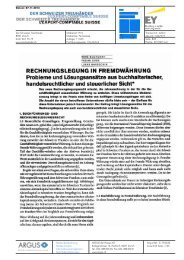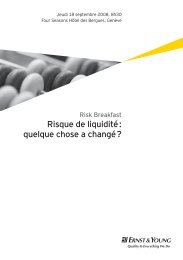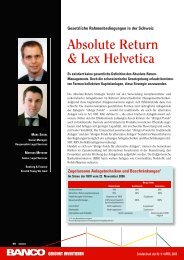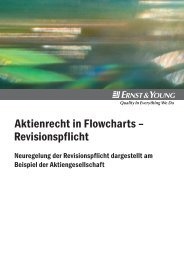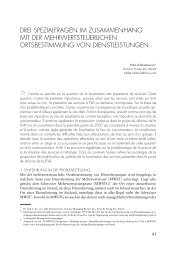New Basel Capital Accord
New Basel Capital Accord
New Basel Capital Accord
- No tags were found...
Create successful ePaper yourself
Turn your PDF publications into a flip-book with our unique Google optimized e-Paper software.
Separate Quantification of Operational RiskUntil now, the process of quantifying therisks to be covered by capital has onlyincluded separate calculations for creditrisk and market risk, with operational riskbeing absorbed by a blanket capitalcharge that was generally too high. Infuture, operational risk will also haveto be separately quantified andcovered by capital. The <strong>Basel</strong> Committeedefines operational risk as "the riskof direct or indirect loss resulting frominadequate or failed internal processes,people and systems or from externalevents".There are also three ways of calculatingthe capital charge for operational risk.Developments subsequent to the SecondConsultative Paper have resulted in bankshaving a choice between the followingapproaches to the capital assessment ofoperational risk: the Basic IndicatorApproach, which applies to the wholebank, the Standardized Approach,which differentiates between businesslines and the Advanced MeasurementApproaches. Advanced MeasurementApproaches will give banks the opportunityto use loss distribution and scorecardapproaches in addition to the InternalMeasurement Approach in calculatingthe capital charge.The simplicity of the Basic IndicatorApproach, which sets the capitalrequirement for operational risk at a fixedpercentage of a bank’s gross income,speaks in its favor, but it has the seriousdrawback of leading to counterproductivemanagement impulses. Thus, increa-sed income resulting from good riskmanagement leads to the negative effectof an increase in the required capitalcharge while a drop in a bank’s incomehas the effect of lowering this capitalcharge.The Standardized Approach, underwhich capital charges are set for differentbusiness lines specified by regulators,leads to a risk-oriented differentiationto some extent. The differences inbusiness and organizational structures inbanks must, however, be taken intoaccount when applying this approach, inorder to establish whether a bank isadequately represented by the specifiedbusiness lines.The Advanced Measurement Approachesintroduced by the <strong>Basel</strong> Committeein September 2001 should enable banksto use a wider range of methods to quantifytheir operational risk from now on.The Internal Measurement Approachindirectly bases the capital requirementon the expected loss from operationalrisk. Under this approach, a bank’s businessactivities will be classified by businesslines, as in the StandardizedApproach. In addition, the <strong>Basel</strong>Committee has defined a certain numberof operational risk types (e.g. depreciationand amortization and legal costs)which will be applied to the individualbusiness lines. The supervisor will specifyan exposure indicator (EI) for everycombination of business line and risktype as a parameter. The expected loss(EL) is the product of the exposure indicator(EI), the probability of loss event(PE) and the loss given that event (LGE).PE and LGE are determined by the banksindependently based on internal loss data(taking external loss data into accountwhere available). The EL for each businessline/risk type combination will thenbe adjusted by a gamma factor suppliedby the bank to determine the capital ratio.Applying the gamma factor presupposesa constant, stable relationship betweenexpected and unexpected loss fromoperational risk.Unlike the Internal MeasurementApproach, the Loss DistributionApproaches are not based on a certainrelationship between expected and unexpectedloss from operational risk, butcalculate unexpected loss directly. Theseapproaches use the loss distributionfunctions of one or more businessline/risk type combinations which banksdetermine themselves through internalmodels. In general, such internal modelsare based on assumptions as to the extentand probability of losses from operationalrisk. By aggregating the loss distributionfunctions in line with supervisorycriteria regarding the assumptionsused, a Value at Risk (VaR) will be determinedand the economic capital for eachbusiness line and risk type calculated.The capital charge for the whole bank isthe sum of these amounts.Unlike the Internal MeasurementApproach and the Loss DistributionApproaches, which are based on histori-16 ERNST & YOUNG – NEW BASEL CAPITAL ACCORD




